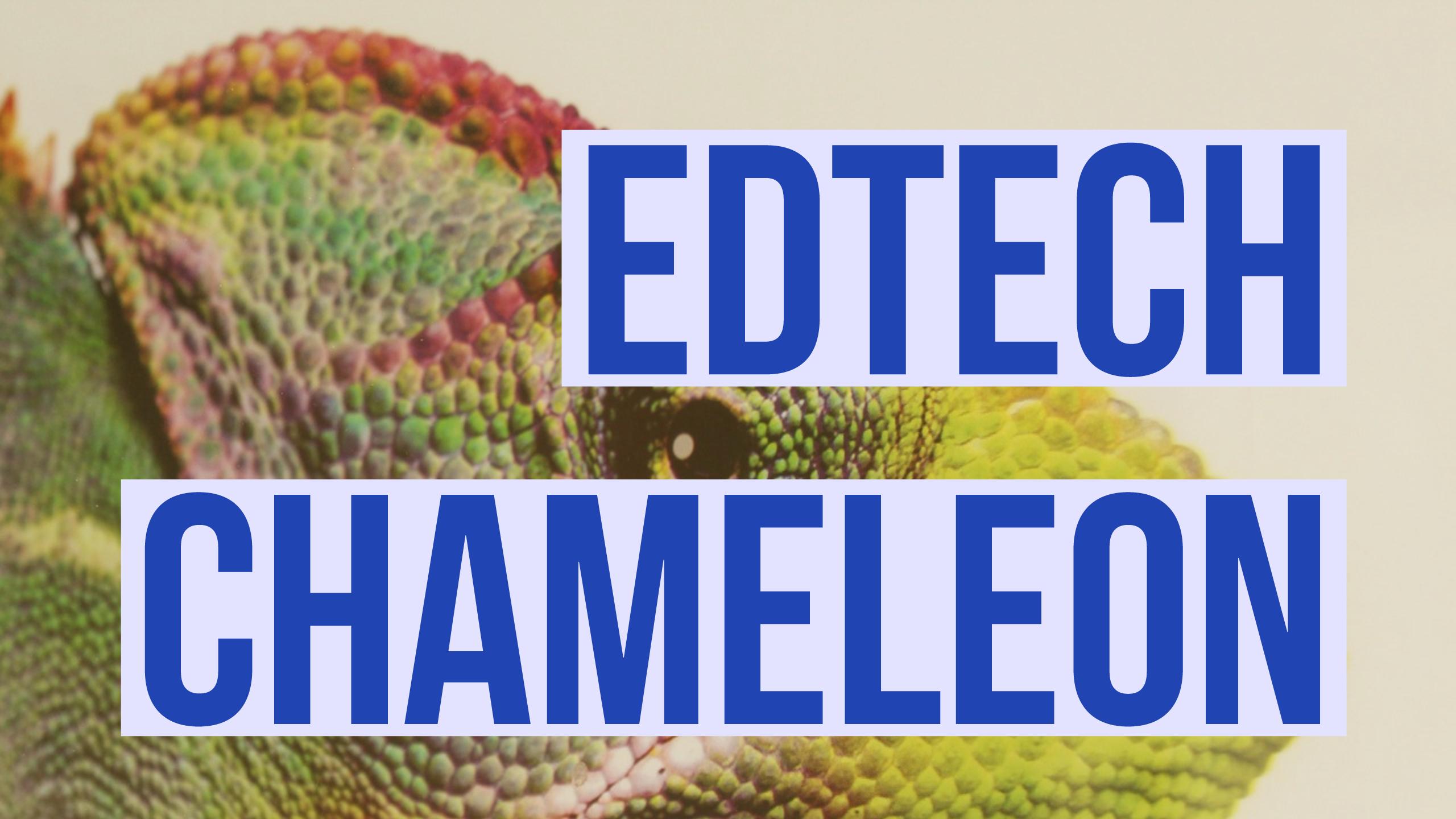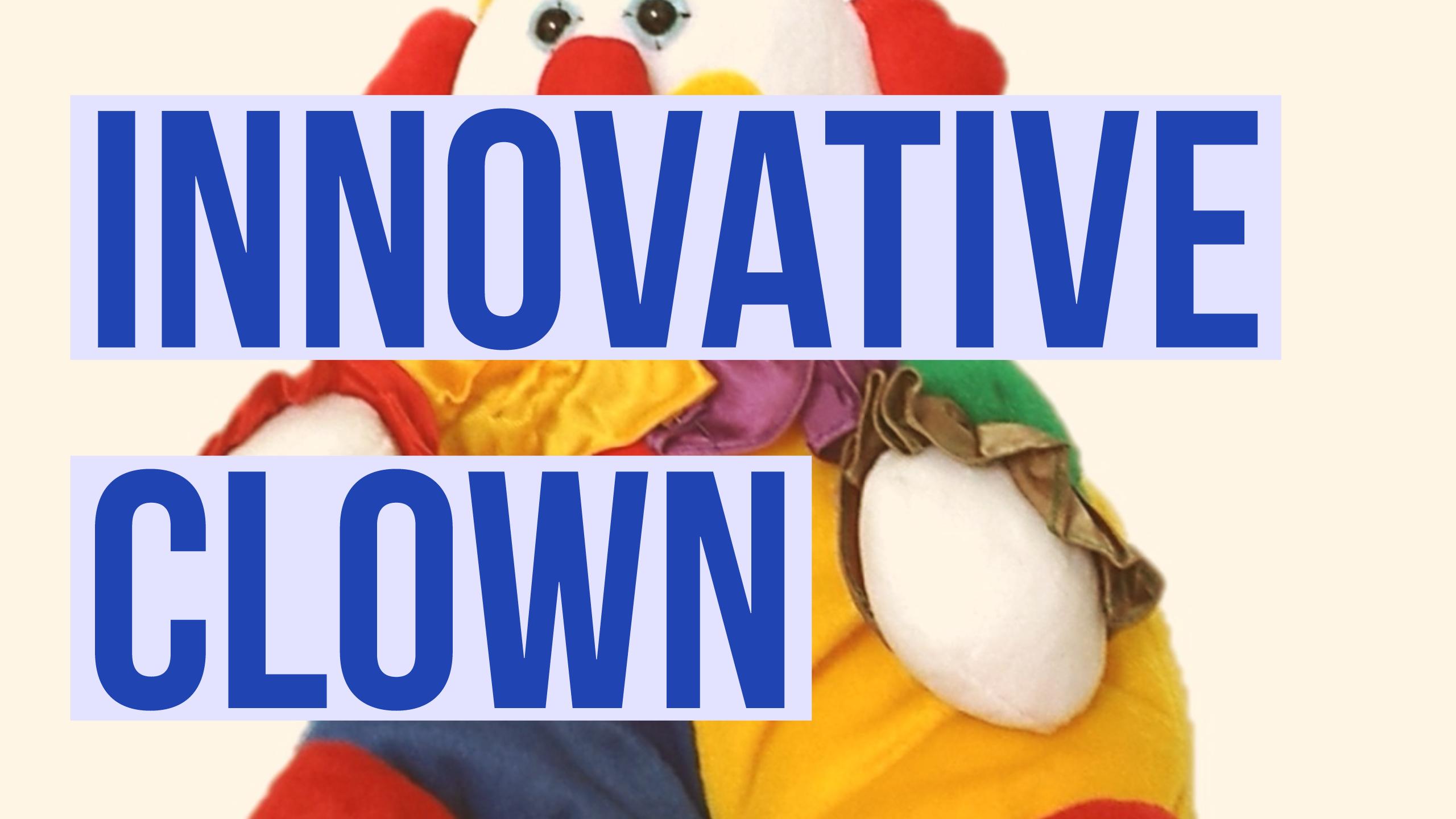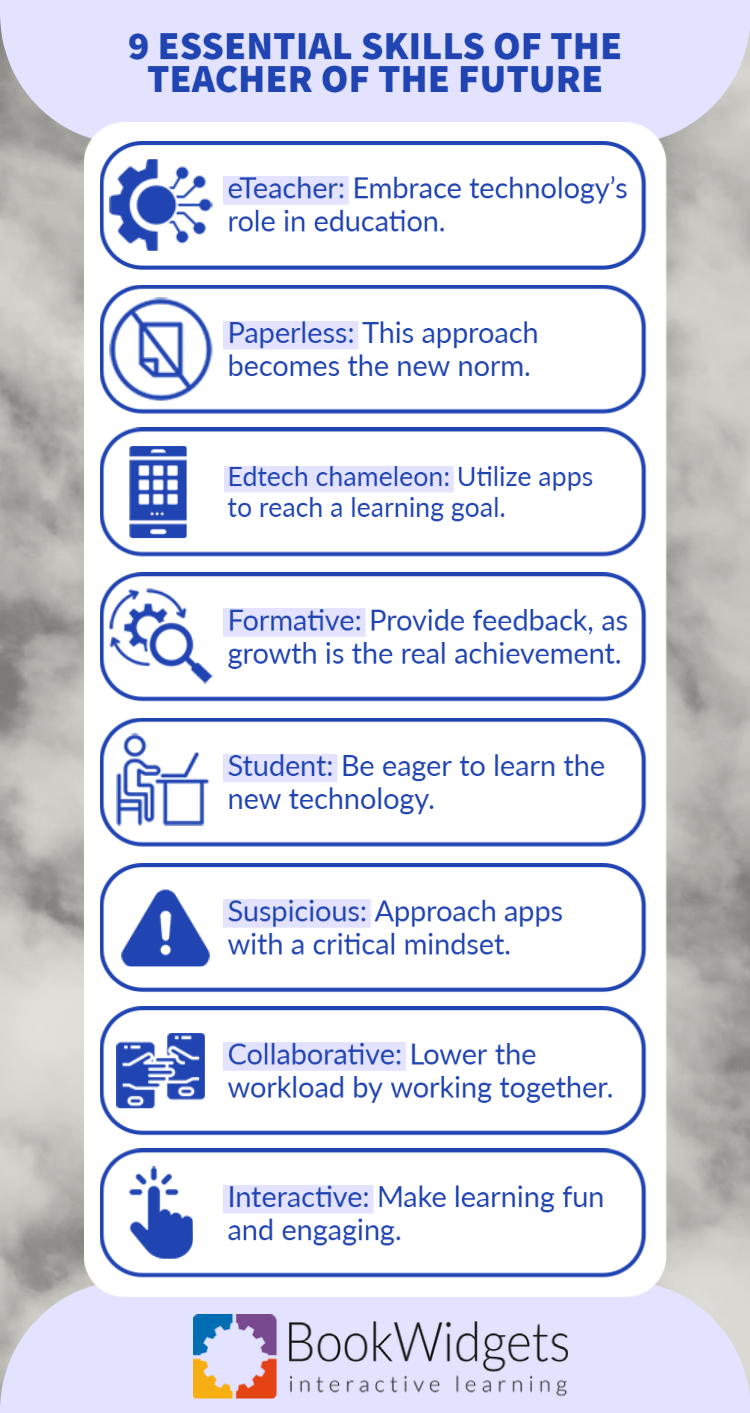8 essential skills of the teacher of the future
 Lucie Renard —
Lucie Renard —
Education is changing. And I’m glad about it. It took a while. And we’re still not there yet… So if education is changing, what is your plan? Are you just keeping it traditional? Or are you changing your teaching too?
I did some research to write this blog post about the teacher of the future. I have some bad news for you when you’re a traditional teacher. Forget about it. Forget ‘being traditional’. Forget the paper worksheets, the talkative teacher and the passive students. Forget the traditional desk work, the chalkboard and pencil sharpener. It’s time for teacher development!
There’s one thing you can’t forget, though: your passion! That’s something that won’t change in the future.
How to be the teacher of the future
So what does a teacher of the future really need to be like? What (new) skills will be crucial for the job? I picked out 8 skills any teacher will need in the future.
1. eTeacher
 The future of education will involve technology. And it won’t be just a little bit. Technology will take over your classroom. As a teacher, you should be prepared.
The future of education will involve technology. And it won’t be just a little bit. Technology will take over your classroom. As a teacher, you should be prepared.
It makes no sense to ignore it. You will only fall behind even more. Be an eTeacher, an innovative clown, a technology junkie.
Be open to use, for example, social media like Facebook, Instagram and Snapchat. Just in your classroom, for educational purposes, of course. Take a look at this post about social media in the classroom for more tips. The more you know about it, the safer it gets for the students. Today, students are always one step ahead when it comes to social media and technology. And they got no one to turn too if something goes wrong.

2. Paperless
 As technology takes over your classroom, it’s also getting rid of the papers. The paperless classroom will become the new traditional classroom.
As technology takes over your classroom, it’s also getting rid of the papers. The paperless classroom will become the new traditional classroom.
Instead of keeping your administration somewhere between thousands of papers on your desk, store them safely on your computer. Instead of wasting at least 100 paper copies per day, provide the assignment by computer or tablet.
Learning management systems already use “paperless” to describe themselves. Now it’s your turn. What do you choose for your paperless classroom?
3. Edtech chameleon
 Education technology apps and tools can help you go paperless. Like I said, learning management systems already offer everything to go paperless, like online grade books, discussion forums and a digital agenda.
Education technology apps and tools can help you go paperless. Like I said, learning management systems already offer everything to go paperless, like online grade books, discussion forums and a digital agenda.
Replace your paper worksheets by digital worksheets on a tablet or computer. There are thousands of different education apps that can make a lesson fun and interactive. Just like BookWidgets. Just embrace technology in education!
But watch out. The apps and tools aren’t the goal. They are just an aid to reach a learning goal. You have to adjust, search and analyze many apps in order to find the right ones for your teaching and goal. Being able to adjust to edtech apps, tools and innovations, being an edtech chameleon makes you the teacher of the future.

4. Formative
 I like to think that the future teacher will get rid of the grade system and focus more on formative assessments and a real feedback culture. And that’s already happening. But like I said, the evolution in education is riding the back of a turtle.
I like to think that the future teacher will get rid of the grade system and focus more on formative assessments and a real feedback culture. And that’s already happening. But like I said, the evolution in education is riding the back of a turtle.
The future teacher won’t value benchmarks and grades anymore. The real value of the student is its progress. It doesn’t matter from where he started. Growing is the real accomplishment.
The future is THE time for feedback. Not just the “Did you even study?” or “you can do better” lines. I’m talking about the real feedback. Take a look at this post about giving meaningful feedback.
5. Student
 When it comes to technology, teachers are rapidly outdated (just like everyone). That’s why the teacher of the future should be more like a student too. Deal with it! Learn how to deal with technology. Learning how to make a document with Word or how to use PowerPoint isn’t enough. That’s what most teachers know now, however that’s not the technology of today.
When it comes to technology, teachers are rapidly outdated (just like everyone). That’s why the teacher of the future should be more like a student too. Deal with it! Learn how to deal with technology. Learning how to make a document with Word or how to use PowerPoint isn’t enough. That’s what most teachers know now, however that’s not the technology of today.
For traditional teachers it’s important to first learn the basics of technology. How do most apps work? What do I do with that link? How can I get something to my students? How can I get my screen displayed on the wall? Once you know the basics, it’s easier to understand more advanced features, apps and tools.
Be eager to learn by yourself. YouTube is the biggest tutorial collection in the world. If you don’t know how something works, just search for the answer on YouTube. Someone probably has made a tutorial of the app. If you lack inspiration and ideas and you don’t know what technology has to offer, take a look at our YouTube Channel EdTech School.

6. Suspicious
 Being an eTeacher doesn’t mean you have to embrace every edtech tool or app on your way. It’s OK to be suspicious once in a while. Not every app works the way it says.
Being an eTeacher doesn’t mean you have to embrace every edtech tool or app on your way. It’s OK to be suspicious once in a while. Not every app works the way it says.
Apps, social media, internet comes with all its disadvantages too. The teacher of the future (and of course the teacher of today) has to know how to handle a threat like cyberbullying.
Another problem that teachers are already facing now is the upcoming fake news. When browsing through the web, looking for information to teach, it’s sometimes hard to distinguish real news from fake news. That’s why you need to be suspicious and check the source and comments to make sure you are teaching the right lesson.
7. Collaborative
 Be like Pinterest and Instagram. Yes, I’m serious. Pinterest and Instagram are the world’s largest and most positive teachers’ lounges. They are filled with positive teachers who love to collaborate and share their ideas.
Be like Pinterest and Instagram. Yes, I’m serious. Pinterest and Instagram are the world’s largest and most positive teachers’ lounges. They are filled with positive teachers who love to collaborate and share their ideas.
Then why is it still so quiet in the real teacher’s lounge? Do you know how your colleagues teach, what materials they use and how they interact with their students?
Technology makes it easier to collaborate with your colleagues. Lower the workload by working together. It’s only getting easier by the rise of learning management systems and other edtech tools that engage collaboration.

8. Interactive
 When I mean that the teacher of the future needs to go paperless, I don’t mean a PDF file on a tablet. When you have tablets and computers, you can make learning more fun and engaging. There are enough apps to keep your students motivated. Take a look at these 7 live edtech tools. I also encourage you to take a moment to delve into this example, created with BookWidgets. That way, you will have a better idea of what your lessons might look like.
When I mean that the teacher of the future needs to go paperless, I don’t mean a PDF file on a tablet. When you have tablets and computers, you can make learning more fun and engaging. There are enough apps to keep your students motivated. Take a look at these 7 live edtech tools. I also encourage you to take a moment to delve into this example, created with BookWidgets. That way, you will have a better idea of what your lessons might look like.
The average attention span of a person has shrunk from 12 seconds in 2000 to 8 seconds in 2013. That’s one second less than that of a goldfish! To respond to that phenomenon, interactive lessons can you help keep your student’s attention a bit longer.
Wrap up
I hope I didn’t scare you, but the future is coming. Ready to hone your future teacher skills? And what about the school of the future? Do you know how it should look like?
I invite you to take these next steps to stay connected:
👉Follow us on Twitter
👉Join our Teaching with BookWidgets Facebook group
👉Connect with me on LinkedIn



